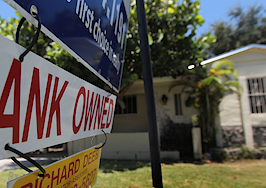The United States housing market may be headed for a soft landing, not a collapse, according to at least one new analysis of inventory, home price and construction material data.
In an Aug. 8 video to agents sure to cause a stir, Altos Research founder and CEO Michael Simonsen posits that despite sluggish growth in inventory and mortgage rates that until recently were on an upward march, home prices have largely avoided further acceleration, suggesting that, while the housing market may have already dipped into a recession, the worst the industry may face is a contraction, not a crash.
“Has the U.S. housing market managed to enter a soft landing?” Simonsen said in the video. “It sure looks like that.”
Simonson pointed to several metrics including the slowing growth of inventory on the market. While there are currently 32 percent more homes on the market than there were at this point last year, there are still 40 percent fewer than there were in August 2019.
The rate of inventory growth rapidly slowed during the first week of August. In June, the amount of homes increased by 6 to 8 percent per week. In July, they increased between 3 and 4 percent per week. During the first week of August, they increased by less than 1 percent, according to Altos’ data.
“Inventory is rising, but rising less quickly than it did in the second quarter,” Simonsen said. “And also actually less quickly than recent Augusts of the last several years.”

Michael Simonsen. Image: Altos Research
The slowing rate of inventory may be tied to a steep increase in lumber prices, which rose 15 percent at the close of the market on Tuesday compared to last week. High lumber prices make it more expensive for builders to complete housing developments, leading to less new inventory on the market.
Simonsen also pointed to the share of listed homes for sale with price reductions, which shot up as homes sat on the market longer, with the share now at around 37.6 percent nationally. The huge increase came as the market shifted and sellers were caught off guard, with many of them feeling forced to drop their prices at once.
“As the market shifted many sellers were surprised and had to cut their asking prices very quickly, so we had this big, steep increase in price reductions, we went from record lows to the highest number in years,” he said. “I expect that by September the rate of price reductions will have leveled off, though.”
Despite the sharp amount of decreased asking prices and growing share of inventory, home prices have remained strong overall, Simonsen pointed out, which combined with mortgage rates already retreating slightly and the economy at large and labor market staying strong, point to a soft landing for the housing market already playing out.
“Mortgage rates have fallen off their highs, employment is super high, people who want to buy are buying,” he said. “This seems very much like a soft landing to me.”













